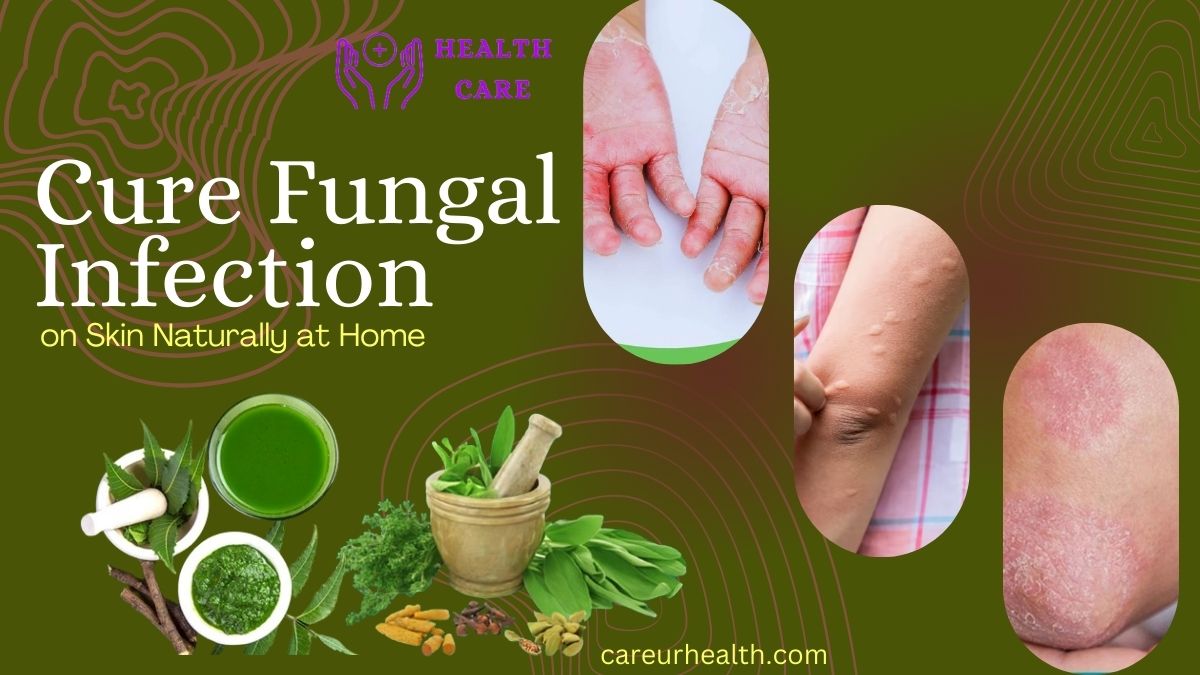Introduction: Natural Remedies for Skin Fungal Infections
Learn how to cure fungal infection on skin naturally at home with simple remedies. Fungal infections of the skin, also known as mycoses, are common and can affect different parts of the body. These infections are caused by various types of fungi, including yeasts and dermatophytes, and can lead to conditions such as athlete’s foot, ringworm, and yeast infections.
While over-the-counter treatments are available, many people seek natural remedies to avoid potential side effects and enhance overall skin health. Discover how to cure fungal infection on skin naturally at home using essential oils.
Here’s how to cure fungal infection on skin naturally at home with aloe vera. This guide explores effective home remedies and natural treatments for curing fungal infections on the skin.
Key Takeaways
- Natural Remedies: Various natural ingredients possess antifungal properties that can help treat skin infections.
- Lifestyle Changes: Maintaining proper hygiene and making specific lifestyle adjustments can prevent fungal infections.
- Herbal Treatments: Certain herbs and plant extracts can be used as natural antifungal agents.
- Diet and Nutrition: A balanced diet can support the body’s immune system and fight off fungal infections.
- Consistency is Key: Regular application and adherence to natural treatment routines are crucial for effectiveness.
Understanding Fungal Infections
Causes of Fungal Infections
Fungal infections are caused by microorganisms that thrive in warm, moist environments. Find out how to cure fungal infection on skin naturally at home with coconut oil.
Common factors include poor hygiene, prolonged moisture exposure, weakened immune system, and contact with contaminated surfaces or infected individuals. Understand how to cure fungal infection on skin naturally at home by maintaining hygiene.
Symptoms and Types
Symptoms vary depending on the type of fungal infection but generally include redness, itching, swelling, and a rash. Common types include athlete’s foot, jock itch, ringworm, and yeast infections. Explore how to cure fungal infection on skin naturally at home with apple cider vinegar.
Risks and Complications
If left untreated, fungal infections can lead to secondary bacterial infections, chronic skin conditions, and spread to other body parts. See how to cure fungal infection on skin naturally at home using garlic paste. Early detection and treatment are crucial to prevent complications.
Natural Antifungal Ingredients
Tea Tree Oil
Tea tree oil is known for its potent antifungal and antibacterial properties. Knowing how to cure fungal infection on skin naturally at home can save time and money. Applying diluted tea tree oil to the affected area can help reduce infection and promote healing.
Coconut Oil
Coconut oil contains medium-chain fatty acids that have antifungal effects. Applying coconut oil to the skin can soothe irritation and combat fungal growth. Tips on how to cure fungal infection on skin naturally at home with diet changes.
Apple Cider Vinegar
Apple cider vinegar has natural antifungal properties and can help restore the skin’s pH balance. Diluted apple cider vinegar can be applied topically or added to bath water.
Garlic
Garlic is a powerful antifungal agent. Crushing fresh garlic and applying it to the infected area can help eliminate fungal infections, though it may cause some skin irritation. Learn how to cure fungal infection on skin naturally at home using turmeric.
Aloe Vera
Find how to cure fungal infection on skin naturally at home with tea tree oil. Aloe vera has soothing and antifungal properties. Applying fresh aloe vera gel to the skin can alleviate itching and inflammation while fighting the infection. Discover how to cure fungal infection on skin naturally at home with neem leaves.
Herbal Remedies for Fungal Infections
Turmeric
Learn how to cure fungal infection on skin naturally at home through proper hygiene. Turmeric contains curcumin, which has antifungal and anti-inflammatory properties. Making a paste of turmeric powder and water or oil can be applied to the affected area.
Neem
Neem leaves have strong antifungal, antibacterial, and antiviral properties. Applying neem oil or a paste of neem leaves can help treat fungal infections. Here’s how to cure fungal infection on skin naturally at home with Epsom salt.
Calendula
Calendula has antifungal and anti-inflammatory effects. The creams or ointments can be applied to soothe and heal the skin. Understand how to cure fungal infection on skin naturally at home using probiotics.
Echinacea
Learn how to cure fungal infection on skin naturally at home with baking soda. Echinacea boosts the immune system and has antifungal properties. Echinacea supplements or topical applications can support the treatment of fungal infections.
Licorice Root
Licorice root extract has antifungal and anti-inflammatory benefits. Applying licorice root gel or cream can help reduce infection and skin irritation.
Hygiene and Lifestyle Changes
Proper Hygiene Practices
Maintaining good hygiene is essential to prevent and treat fungal infections. This includes regular bathing, keeping skin dry, and changing clothes frequently.
Avoiding Moist Environments
Fungi thrive in moist environments. Ensure to dry off completely after bathing and avoid wearing damp clothing or footwear.
Wearing Breathable Fabrics
Opt for breathable fabrics like cotton to reduce moisture buildup on the skin. Avoid tight clothing that can trap sweat and heat.
Regular Foot and Nail Care
Proper foot and nail care can prevent fungal infections like athlete’s foot and toenail fungus. Keep feet clean and dry, and trim nails regularly.
Avoiding Shared Personal Items
Do not share personal items such as towels, shoes, or clothing with others to prevent the spread of fungal infections.
Diet and Nutrition
Probiotics
Probiotics support a healthy balance of gut flora, which can boost the immune system and help fight fungal infections. Include probiotic-rich foods like yogurt and kefir in your diet.
Antifungal Foods
Certain foods have natural antifungal properties, such as garlic, onions, and ginger. Incorporate these into your meals to help combat infections.
Avoiding Sugar and Refined Carbs
Sugar and refined carbs can feed fungal infections. Reducing their intake can help manage and prevent fungal growth.
Hydration
Staying hydrated supports overall skin health and the immune system. Drink plenty of water throughout the day.
Balanced Diet
A balanced diet rich in vitamins and minerals supports the immune system and overall health. Focus on whole foods, vegetables, fruits, lean proteins, and healthy fats.
Essential Oils for Fungal Infections
Lavender Oil
Lavender oil has antifungal and soothing properties. It can be applied topically, diluted with a carrier oil, to the affected area.
Oregano Oil
Oregano oil is a powerful antifungal agent. Dilute it with a carrier oil before applying it to the skin to avoid irritation.
Peppermint Oil
Peppermint oil has antifungal and cooling properties, providing relief from itching and inflammation. Use it topically in diluted form.
Eucalyptus Oil
Eucalyptus oil has antifungal and antibacterial effects. It can be used in a diluted form for topical application.
Lemongrass Oil
Lemongrass oil has strong antifungal properties. Dilute it with a carrier oil and apply it to the infected skin.
Home Remedies for Common Fungal Infections
Athlete’s Foot
Treat athlete’s foot by soaking feet in a mixture of apple cider vinegar and water. Apply tea tree oil or coconut oil to the affected areas.
Ringworm
For ringworm, apply a paste of turmeric and water to the affected area. Use aloe vera gel to soothe itching and inflammation.
Jock Itch
Coconut oil and tea tree oil can be effective for treating jock itch. Ensure to keep the area clean and dry.
Yeast Infections
Apple cider vinegar baths can help with yeast infections. Garlic paste or coconut oil can be applied to the infected area.
Nail Fungus
Soak nails in a mixture of vinegar and water. Apply tea tree oil or oregano oil to the affected nails regularly.
Preventative Measures
Regular Cleaning
Regularly clean and disinfect household surfaces, especially bathrooms and kitchens, to prevent fungal spores from spreading.
Proper Ventilation
Ensure proper ventilation in living areas to reduce humidity and prevent fungal growth.
Avoiding Contaminated Areas
Avoid walking barefoot in communal areas such as gyms, locker rooms, and swimming pools to prevent exposure to fungal infections.
Immune System Support
Boost your immune system through a healthy diet, regular exercise, and adequate sleep to help your body fight off infections.
Skin Care Routine
Develop a regular skin care routine that includes moisturizing and protecting the skin from excessive moisture or dryness. Explore how to cure fungal infection on skin naturally at home using ginger.
Natural Antifungal Bath Solutions
Epsom Salt Bath
Epsom salt has antifungal properties and can soothe the skin. Add Epsom salt to your bathwater and soak for 15-20 minutes.
Baking Soda Bath
Baking soda helps restore the skin’s pH balance and has antifungal effects. Add baking soda to your bath and soak for relief.
Vinegar Bath
Vinegar, particularly apple cider vinegar, has antifungal properties. Add it to your bathwater to help treat skin infections.
Herbal Bath
Use a combination of antifungal herbs like neem, lavender, and chamomile in your bathwater for natural treatment. Knowing how to cure fungal infection on skin naturally at home can prevent recurrence.
Essential Oil Bath
Find out how to cure fungal infection on skin naturally at home with proper hygiene. Add a few drops of antifungal essential oils like tea tree, lavender, or eucalyptus to your bath for an enhanced healing experience. Discover how to cure fungal infection on skin naturally at home using vinegar.
Case Studies and Success Stories
Case Study 1: Athlete’s Foot Treatment
A patient successfully treated athlete’s foot using a combination of apple cider vinegar soaks and tea tree oil applications. Consistent use over four weeks resulted in significant improvement and eventual clearance of the infection.
Case Study 2: Yeast Infection Relief
A woman with recurrent yeast infections found relief through the regular use of coconut oil and garlic paste. These natural remedies reduced symptoms and prevented future occurrences. Here’s how to cure fungal infection on skin naturally at home with herbal baths.
Case Study 3: Ringworm Eradication
A teenager cured a persistent ringworm infection by applying turmeric paste and aloe vera gel. The natural treatment proved effective, showing results within two weeks. Find out how to cure fungal infection on skin naturally at home using honey.
Case Study 4: Jock Itch Management
A man managed chronic jock itch by incorporating tea tree oil and proper hygiene practices. The condition improved significantly with consistent treatment and lifestyle changes. Discover how to cure fungal infection on skin naturally at home by keeping skin dry.
Case Study 5: Nail Fungus Cure
A woman suffering from nail fungus saw improvement after soaking her nails in vinegar and applying oregano oil. Over several months, the natural treatment cleared the infection and restored nail health. Learn how to cure fungal infection on skin naturally at home using essential oils.
Conclusion
Natural remedies for curing fungal infections on the skin offer effective and safe alternatives to conventional treatments. By utilizing ingredients with antifungal properties, maintaining proper hygiene, and making necessary lifestyle changes, individuals can successfully manage and cure fungal infections at home.
Consistency and patience are key to seeing results, and integrating these natural approaches can lead to healthier skin and overall well-being. Knowing how to cure fungal infection on skin naturally at home can improve health.
Treating fungal infections on the skin naturally at home is not only possible but also effective with the right approach. Utilizing natural remedies such as tea tree oil, coconut oil, apple cider vinegar, garlic, and aloe vera can provide relief.
And aid in healing without the side effects of some conventional treatments. Consistency is key—regular application of these remedies is crucial for success.
In addition to topical treatments, adopting good hygiene practices and making lifestyle adjustments can significantly reduce the risk of recurrent infections. Keeping the skin clean and dry, wearing breathable fabrics, and avoiding shared personal items are simple yet effective measures.
Diet and nutrition also play a vital role in supporting the body’s defense against fungal infections. Including probiotic-rich foods, reducing sugar intake, and maintaining overall hydration can enhance the immune system and prevent fungal growth.
FAQs: How to Cure Fungal Infection on Skin Naturally at Home
1. What are the best natural remedies for skin fungal infections?
Some effective natural remedies include tea tree oil, coconut oil, apple cider vinegar, garlic, and aloe vera. These ingredients have antifungal properties that can help treat infections.
2. How often should I apply natural remedies to my skin?
For best results, apply natural remedies like tea tree oil, coconut oil, or aloe vera gel two to three times a day until the infection clears up.
3. Can lifestyle changes help prevent fungal infections?
Yes, maintaining proper hygiene, keeping the skin dry, wearing breathable fabrics, and avoiding shared personal items can help prevent fungal infections.
4. Are there any dietary changes that can help with fungal infections?
Incorporating probiotics, antifungal foods (like garlic and onions), reducing sugar and refined carbs, and staying hydrated can support the body’s ability to fight fungal infections.
5. When should I see a doctor for a fungal infection?
If the infection doesn’t improve with natural remedies, worsens, or spreads, it’s important to see a doctor for proper diagnosis and treatment.
The Yoga Institute










